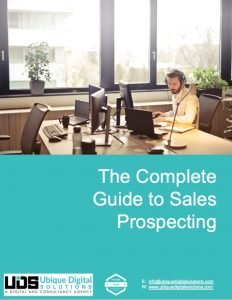For Starters
Overview of Sales Prospecting
The time crunch countdown begins each day of every week of every month for us. It’s the one aspect of sales that just never changes.
As we’ve all experienced, sales essentially boils down to two things:
- Numbers
- Time
And those two things often go hand-in-hand. While we (or our team) are racing to hit quota against that clock, we can save time and maximize our numbers by investing in the right processes, activities, and skills.
Truth is, sales is changing — quickly. As sales conversations grow even more buyer-focused, sales reps have begun developing their own hacks, techniques, and processes for prospecting.
That’s where this guide comes in. In this growing sales landscape, we’ll outline the various processes and key strategies for prospecting — the phase of selling that often consumes the most time and energy (and is the most crucial to get right).
Reminder
Quick Refresher
Regarding Prospecting, Leads And Others

What Is Prospecting?
Prospecting is the process of searching for potential customers, clients, or buyers to develop new business. The end goal is to move prospects through the sales funnel until they eventually convert into revenue generating customers.
What’s A Lead Vs. A Prospect?
Leads: Potential customers who have expressed interest in our company or services through behaviors like visiting our website, subscribing to a blog, or downloading an ebook.
Prospects: Leads become prospects if they are qualified as potential customers, meaning that they align with the persona of our target buyer. A prospect may also be classified as a potential customer who has limited or no interaction with our company, but they would not be considered a lead.
Quick Refresher
Leads or prospects, the end goal is the same: Nurture potential customers until they buy our product or service.
Here is what the process looks like:
Research To Assess Quality Of Lead
Qualifying dimensions: A set of criteria to evaluate the probability that a lead or prospect will become a customer.
CRM: Software that allows companies to keep track of their potential and existing customers at whichever stage they assume in the sales cycle.
Prospect To Get A Connection
Gatekeeper: Person in charge of communicating or preventing information from reaching a decision-maker
Decision-maker: The person in charge of making a final decision on the sale. We usually have to go through a gatekeeper to reach them.
Connect To Schedule Next Meeting
Discovery call: The first contact a sales rep makes with a prospect with the aim to qualify them as a lead for the next step in the sales cycle
Educate And Evaluate To Find/Qualify Needs
Pain point: A prospect’s business need; this is what sales reps must identify to offer value and move them farther along in the sales cycle.
Close To Turn Opportunities Into Customers
Closed-lost: When the buyer fails to buy a product or service from the sales rep.
Closed-won: When the buyer buys a product or service from the sales rep.
Closing ratio: Ratio of prospects that a sales rep closes and wins.
Prospecting
Sales Prospecting Techniques
In A Sales Environment
As the sales environment matures, we’re seeing a shift from and either/or methodology of prospecting. Reps no longer have to choose between inbound or outbound prospecting.
Here’s the big difference in the two methodologies:
Outbound Prospecting
Cold calling: Unsolicited calls to sell a product or service
Social spamming: Unsolicited social media messages to sell a product or service
The process: Research takes longer without any prior history with a contact. Less context for us when we’re ready to reach out to establish a connection.
Example: “Hi John, I wanted to reach out to you because I’ve worked with companies like yours in the past.”
Inbound Prospecting
Warm emailing: Warm emails to explore a relationship with a lead who has already expressed familiarity with your product or service
Social selling: Using social media to explore a relationship with a lead; sales reps can offer value to prospects on social media by answering their questions and introducing them to useful content
The Process: Research process is shorter as we already have their contact information and interaction history. Gives us context about the prospect’s interests or prior behavior, allowing us to develop more personalized outreach.
Example: “Hi John, I’m reaching out because I noticed you were looking at our ebook on improving sales productivity.”
Our Recommendation
The Inbound Methodology
Attract | Engage | Delight
Attract Tools
- Calling
- Prospects
- Email templates
- Meeting scheduling
- Conversational tools
Engage Tools
- Deals
- Videos
- Playbooks
- Email sequences
- Sales automation
Delight Tools
- Quotes
- Sales automation
- Smart notifications
- Conversations inbox
- Conversation routing
… with a responsible approach to outbound tactics like cold calling and cold outreach. Because, let’s face it — not every lead you get
will be “warm.”
Our world is now characterized by infinite information, whenever we want.
Before we make a purchase decision, 60% of us rely on word-of-mouth, friends, and social media; 49% on customer references; 47% on analyst reports and recommendations; and 44% on media articles
Before a salesperson even has a chance to contact a prospect, he or she is already 57% of the way through the sales process. Yet, salespeople are still cold calling as if buyers have no awareness. Experienced salespeople can expect to spend 7.5 hours of cold calling to get ONE qualified appointment, according to a Baylor University study.
Companies using inbound and responsible outbound sales techniques are better positioned for success in this new realm of buyer awareness. In fact, 64% of teams that use inbound selling reach their quotas as opposed to 49% of sales teams who use only outbound sales. IBM even increased their sales by 400% after implementing their inbound sales program.
The Guide
A Guide To Prospecting
The Various Steps

50% of sales time is wasted on unproductive prospecting.
We don’t want you to fall into that sales statistic.
That’s why we recommend the inbound way and put together a basic framework that applies to all sales processes. But with a twist.
As we mentioned earlier, we understand that everyone has their own approach. So we’ve also weaved in personal prospecting tips and tricks from the best salespeople we know. Pick and play with whatever works best for your own sales hustle.
Step 1: Research
This is by far the most important aspect of prospecting. We must make sure that we’re qualifying our prospects to improve our chances of providing value to them or their business.
In this stage of prospecting, we’re looking to accomplish a few goals:
● Decide if the prospect is workable
● Qualify and begin ranking prospects
● Find opportunities to develop a connection through personalization, rapport building, and trust development.
Is the prospect’s business an organizational fit?
This type of qualification is based solely on demographics. Does the prospect fall within my territory? Do we sell in their industry? Does it fit our buyer persona?
Say our target market consists of small to medium-sized businesses with anywhere from 100 to 1,000 employees. We should eliminate any potential customers outside of these criteria.
Diving deeper, our product or service will naturally offer higher value to a particular profile within that target market. For example, medium-sized businesses consisting of a larger team. Those customers are also more likely to upgrade to a higher tier of our product, providing more lifetime value as a customer.

Key Takeaway:
Rank customers based on the size of the opportunity, or their potential lifetime value.
Have you identified key stakeholders?
There are two types of people involved on the other end of our sales process: Decision-makers and influencers.
Influencers may not have the power to buy, but they’re often the ones that will be using the product and thus can become our biggest internal advocates. If we get them to rally around our offering, they can make a compelling case to decision-makers before we even speak with them.
Decision-makers are, of course, the ones that either approve or reject the buy. We can ask these questions to determine the decision-making process: Will anyone else be involved in this decision? Does this purchase come out of your immediate budget?

Key Takeaway:
Keep a working list of influencers and buyers, perhaps mapped out by the organizational structure of the organization. We’ll use this list later when we’re in the outreach phase of prospecting.
Do you have familiarity with the market?
We’re likely to be more familiar with certain types of companies, markets, or industries than others. Our pitch and sales techniques are also likely to be more refined with markets we feel comfortable talking about, so we should rank these prospects first.
Key Takeaway:
Group similar prospects by characteristics such as their service offering, their market, or their industry, and rank these groups based on our familiarity with them.
Value-added prospects to whom we can offer more value are more likely to buy. For example, if we’re selling basic digital marketing services and we see that our prospect already has a robust web presence, the probability we can create tremendous added value is low.
Key Takeaway:
Classify prospects by the level of value we think we can offer.
Do they have an awareness of our offering?
Our prospects will likely have varying levels of knowledge about our product or services. The more awareness they have, the more likely they are to see the value in our offering and become customers. If a prospect has visited our website, subscribed to our blog, or posted content about something related to our offering, they probably know a lot about our company or service.
Based on our research, we should have a fine-tuned profile of our target customer, and every company or individual on our prospect list should meet those criteria.
Step 2: Prioritize

Prioritizing our prospects can save us time and make sure we’re dedicating our strongest efforts to prospects that are most likely to become customers. Levels of prioritization will vary between each type of sales organization and each individual salesperson, but the main idea is to create a few buckets of prospects based on their likelihood to buy and focus on one bucket at a time.
Let’s break down the qualifying dimensions used in our list above (and any added relevant dimensions) into percentages between 1% and 100% based on how important they are to the sales process.
For example, size of opportunity is probably more important to us than timing when closing a deal, so it would receive a 70% whereas timing would receive a 5%.
Now we can assign a value between 1 and 100 to these dimensions for each prospect in our list. Once we complete this step, we can multiply each prospect’s value by the percentage weight we gave to the dimension. Add up these dimension scores until each prospect has a total score. And now our entire list is ranked.
Step 3: Prep The Outreach
The end goal of this step is to gather in-depth information on our prospects to hone our pitch and personalize our outreach. So first, we must find what our prospects care about.
We can do this in a few ways:
- See if the prospect blogs to define what they write about (as a proxy for what they care about)
- Find their social media presence. Do they have recent updates or a new post?
- Check the company website to review “About Us” information

Once we’ve learned more about our prospect’s business and role, we need to find a reason to connect. Do we have mutual connections? Has there been a trigger event? Have they recently visited our website? If so, which search terms drove them to our site? Which pages did they look at?
If we want to get more high-level with our prep, we can create a decision map to outline our prospect’s options and end-goals. This will help us better handle any objections and personalize a pitch that resonates with their primary objectives. We could also conduct a competitive analysis to determine how we can better position our company’s service or product within the industry and how we can combat prospects’ objections.
Step 4: The First Touch
In terms of establishing contact, we must decide between email or phone communication. Some of us will initially jump on the cold email approach while others will dive into the cold call. This strategy will vary based on what each salesperson feels most comfortable with, but let’s quickly review pros and cons to both.
Phone
Pros
- Calls are less common than email, so they can grab a prospect’s attention quickly and more easily
- Immediately establishes a more intimate connection and offers salespeople the chance to develop rapport
- Often more timely than email communication and can speed up the time it takes to close a deal
Cons
- Some prospects may feel overwhelmed by a call and thus be less inclined to consider a pitch or schedule a second meeting
- There’s no guarantee a prospect will pick up
- Voicemail can often be as cluttered as email
Pros
- Visual
- Allows prospect to consider our offer
- Gives prospect adequate time to research our company and product
Cons
- Email is a cluttered space so it may be harder to grab a prospect’s attention
- Emails are easily deleted and forgotten
- We may have to follow up multiple times before getting a response
But, how do we leave a voicemail or send an email that prospects want to respond to?
Let’s dive into the dos and don’ts of each communication method below:

The Prospecting Call – If we decide to call a prospect, whether in conjunction with an email or not, we can follow this basic structure for the call:
- Establish rapport: We shouldn’t shy away from personal conversations, like asking how a prospect’s weekend was or what team they’re rooting for in the game tonight. These intimate touches help us develop a more meaningful relationship with prospects and enhance our likeability which, hopefully, means a prospect will be more likely to buy from us.
- Leverage pain points: Dive into their pain points during the call. By the end of the conversation, we should know all of their primary business challenges and the underlying causes associated with them. Once we have an understanding of these key issues, we can better position our product or services to solve them.
- Create curiosity: Ask questions about their business. Ask more than tell. This conversation is about them and understanding their needs and problems. The less we talk about our business and product, the more our prospect will be interested to hear the final pitch.
- Wrap it up: Find a calendar time between 24-48 hours after discovery call to book a follow-up meeting. Try this line: “Would you have 30 minutes to follow up this week? My colleague, John, will join us — he’s an expert in X, Y, Z. My calendar’s open, what works best for you?”

The Warm Email – If we’re looking to send a first-touch email that gets opened, there are some essentials that we must include:
- Engaging subject line: The subject line has to pique the prospect’s interest while avoiding cliché hooks.
- Personal opening line: We should begin our cold email by saying something about them, not about us. After all, this process is about finding the prospect’s pain points and determining a way to add value to their business or processes.
- Creating a connection: Now we have to make the connection. In our opening, they learn why we’re reaching out to them, but now they need to know why they should care about what we do.
- Clear call-to-action: Suggest a concrete time to connect or ask a close-ended question to make it clear that the ball is in their court. Try using one of these lines: “Do you have ten minutes to catch up tomorrow?” or “Are you available for a 30-minute call on Tuesday between 9-11 a.m.?”
Step 5: Iterate

Keep notes throughout this process to assess what activities generated value for the prospecting process and which wasted time.
After each contact with a prospect, we should assess how well we think we:
- Uncovered challenges
- Helped create well-defined goals
- Confirmed availability of budget
- Understand decision-making process
- Determined consequences of inaction
- Identified potential results of success
This self-reflection will help us improve our calling techniques in the future.
Tools Examples
Sales Prospecting Tools
Various Tools For Your Sales Needs
We can use Twitter to get an idea of what our prospect finds important. By showing them support through a retweet or favorite, or even engaging them in conversation, we can show them that we have their interests, challenges, and needs in mind. Because we’ve already opened the relationship through a personal medium like Twitter, we’ll have a greater window of opportunity to adjust our pitch.
How to use it: To inform the sales process. Use Twitter’s Advanced search to quickly sift through a prospect’s feed and find what’s important. For example, if we see that a prospect posted a question about our product, it’s a perfect opportunity to respond.
CRM
HubSpot’s CRM allows users to keep track of sales activity and source new prospects.
How to use it: Surface warm prospects who have already visited our website. Store contacts and companies, track deals and easily manage tasks such as follow-ups and meetings.
Hubspot Connect
Connects the web apps you use to automate tedious tasks.
How to use it: Search the integration library to connect the apps and web services you use every day to your HubSpot account.
Hubspot Sales Hub
Use email tracking to know when prospects open emails, click on links, or open attachments. HubSpot Sales also offers detailed contact information right in your inbox and allows you to schedule emails to be sent when you know your prospect will be most likely to open them.
How to use it: If we see that a prospect is viewing an email we sent two weeks ago, we can follow up with information related to what they’re viewing, or email them to set up another meeting.
LinkedIn Company Pages
This gives us a feed on the company’s recent updates to help discover industry news, marketing campaigns, events, product launches, and recently published content.
How to use it: We can reference these updates as trigger events to engage our prospects in real conversations.
Google Alerts
Google Alerts allows us to track web mentions on a company’s name, product, competitors, or industry trends.
How to use it: Customize alerts to send real-time, daily, weekly, or monthly updates on whichever keywords are relevant to our prospects. We can use these to tailor our outreach.
Datanyze
Datanyze tracks competing technology providers and informs us of companies who have started or stopped using their solution.
How to use it: Connect with prospects after they stop using a competitor’s product to catch them while they’re on the market for a better offering.
FoxClocks
This is an extension for Chrome and Firefox that lets us keep track of local or foreign time zones in our status bar.
How to use it: Manage time zones and never miss a meeting due to a misunderstanding between PST, EST, CT, etc.






